I like spring, it means that new baby orphans will be coming in, the land comes back alive ... but fall has come. The trees know it, the animals know it. Since I have gotten back from Tufts from the Chemical Capture Class, I have known that fall is coming. The Chemical Capture Class was great, I hope to be darting animals soon to save them.
For the last few days, I have been dreading today. It was release day. My day started early with preparations to catch, cage, transport and release skunks and coons. I try not to get emotionally attached to the wildlife I rehab. My first coons came in May 9th ... skunks came shortly after. Watch the slideshow that Gayle will hopefully attach to this blog and link to the website.
Release day is always tough for me. I know that they are ready, they have been enriched, and can figure out any food item that I slip in. Every year we get "better" , we never claim to know anything here but we are quick learners and once we make a mistake (which all rehabbers do) we learn. That is why I mentor. That is why I'm lucky to have Kelly as one of the best mentors in the world. Never a day passes that I don't scratch my head, say "never saw that before" ... and learn.
I really don't know what to say about today, I moved the Kestrels into their soft release enclosure. The 'Possums moved out into theirs.
The darn cage that Oscar the Bobcat was in is 1/2 an inch too large to slide into the aluminum zoo cage that I use to transport him to Cornell. I have to take him there tomorrow and it wasn't pleasant getting him into a cage with a catch pole now.
I really think that if you watch the slideshow and listen to the music that Gayle put to it from today, you will get what I do ... very few people get what I do. 5 months of my life has revolved around these animals; baby coons and stinkers; 24 hours a day, 7 days a week--no breaks. It all boiled down to today. Did I get them prepared for life in the wild and things that could eat them in the woods? I think so. If you watch the slideshow, you will see one eyed (black eyed) Susie as I called her, This is the coon that Dr. Diane saved for me. We both spent a lot of time and money on her; she was the only coon that kept coming back to me for reassurance--all of the others plunged into the wild. I am comfortable with the release, I am happy for them al. Once I drive away, they are on their own. It was the way that it is suppose to be, they are not pets. They are wild animals, for better or for worse.
I got home, depressed, in a bad mood which everyone at the farm got. Started getting things ready for Cornell trip tomorrow with Oscar the Bobcat because I start school on Wednesday.
Got a phone call about an owl in someone's yard, she called nonstop until we answered the phone ... she knows I don't check the answering machine more than once a day. I went, found a great old Great Horned Owl that was sitting under her picnic table. I had caught it before the kids could even get out of the house. What an old warrior; he had reserved himself to hunting a Porcupine and a couple of weeks ago had caught one. I pulled several quills out of a horribly infected foot. Glad I'm going to Cornell tomorrow--if anyone can save this foot....they can. Also had to set a livetrap for a red fox with mange: met a great guy who doesn't want to see his fox from his farm die a horrible death. I will try to catch it. I will and I will fix it.
I have several people a week say that what I do is amazing, I do not get funding; it is all by donation and my blood, sweat and tears. Forward everyone you know our blog, website and slideshow of our release today. I am the luckiest guy in the world that I get to do this every day.
My kids will look back at these releases as they get older and releaze how cool they were versus "Why can't I get out of the truck?".
I look forward to getting back in my classroom, I miss the kids from school. I need to see some kids (as if I haven't seen them all summer).
Plan on attending the Scottish Festival this weekend at the Altamont Fairgrounds. The Committee has supported what I do for years. I will be doing two shows daily.
Gotta hit the hay.
Wes
Please also see our other blog at
http://nywildliferescue.blogspot.com/
It is more active than this one. Always check there for updates, too.
Northeast Llama Rescue was started by Wes and Darcy Laraway of Middleburgh, NY.
Several years ago they rescued their first llama out of a tiny horse pen. Since that day, Northeast Llama Rescue has helped dozens of Camelids from several different states. The primary mission of Northeast Llama Rescue is to educate owners on how to properly care for their animals.
We also offer assistance with a traveling chute to shear, worm, and trim toenails on hard to handle animals. A 'TRUE REPUTABLE BREEDER" should help out the llama down the road that is not being cared for by owners that understand the needs of llamas.
If you know of a llama owner who is no longer able to care for their animals, there is help available. Members of Northeast Llama Rescue will adopt any unwanted animals. Rescue animals will be relocated to farms of members for training and necessary vet work.
If a llama is able to be rehabilitated, he will be available after a careful screening process. All rescues are placed in homes with a contract that says they shall be provided for and can not be sold. In the event a rescue animal becomes unwanted, the llama MUST be returned to Northeast Llama Rescue.
If you share our philosophy and love for the animals, you are more than welcome to join us! There are lots of llamas that need a person to love.
We also rescue farm animals, and are licensed wildlife rehabilitators.
This site is copyrighted by Wes Laraway.
Tuesday, September 1, 2009
Subscribe to:
Post Comments (Atom)
Northeast Llama Rescue by Wes Laraway
The Northeast Llama Rescue was started by Wes and Darcy Laraway several years ago after they rescued their first llama out of a tiny horse pen. Since that day, the Northeast Llama Rescue has helped dozens of animals in 5 states. The primary mission of Northeast Llama Rescue is to educate owners on how to care for their animals properly. We also offer assistance with a traveling chute to shear, worm and trim toenails on hard to handle animals. If owners get "tired" of the daily maintenance of their herds, members of the Northeast Llama Rescue will adopt or buy, if possible, any unwanted animals. Rescue animals go to the farms or members of the organization.
The Northeast Llama Rescue does not wish to compete with other rescue organizations, although any llama or alpaca is welcome. We need to cooperate to help ALL camelids, not just registered or "nice-looking" ones. Everyone has the right to breed and sell llamas, but a true reputable breeder will "help out" the llama down the road that is not being cared for, regardless of its age, sex or conformation.
Our last rescue came from Central New York. A farm had purchased 9 animals from a Midwest auction. Four of the animals had died from natural causes....starvation? The owner had health problems and no longer wanted the animals. After several other concerned people failed to negotiate their sale, I eventually called and within five minutes we had agreed on a price and the deal was done. The next night, Wes Laraway, Kim Scheurerman and P.J. Wagner went to pick up the animals. The owner informed us that the llamas were wild and could not be handled. Within five minutes all were calmly caught, on lead ropes and in the trailer, with us using a wand and some TEAM Training techniques. The owner thought I was the "llama whisperer" because I got those llamas to do things in five minutes that she couldn't do in a year. She unfortunately knew nothing about handling llamas.
Three hours later, we were back into quarantine at Red Maple Farm starting "damage control". The animals were immediately wormed, fed fresh hay and grain, and watered. All were body scored under three by sight and by feeling through their wool. This hands-on inspection revealed barbed wire that needed to be cut out of the fiber. We decided NOT to shear because it was too late in the year and they were too thin.
Another concern was an ingrown halter. One of the best ways to remove ingrown halters is to undo the buckle(s) and cut the nose band with sharp toenail clippers on each side of the nose. Then gradually, over time, the remaining pieces will fall out. With application of an antibiotic cream, any wounds from the ingrown halter will heal quickly. In this particular case, the halter came out of the nose and was added to the "wall of shame" in our barn (along with the barbed wire and ear tags still on them from the auction they were purchased from). The blood stream stopped within fifteen minutes and now, after a month, we can tell that scarring will be minimal. Please tell everyone you know that owns camelids, NEVER leave a halter on a llama! Even in a week, with wet conditions, a halter can embed itself in a llama's nose.
My biggest concern was the 10 month old female that was exposed to her father. If bred, we decided to abort the unborn cria for the safety and well-being of the young female. None of these five animals were over the age of three years. All of them, over the following months, would need intense care and proper nutrition. The animals were all updated on health requirements and gelded. All of these animals would need training before they could go up for adoption.
New problems continuously arose. Two weeks after they arrived, one of the females surprised us with a weak, constipated fourteen pound male cria. Within hours I knew it wasn't "normal" so mom and baby were moved to a quarantine pen in the barn. The decision was made to supplement the cria with goat colostrum and give him an enema. Although the cria was walking, he continued to strain to relieve himself. Around the clock surveillance did not reveal any nursing or defecation. At two days old, I found very small maggots between the cria's toes and by his umbilical cord. After consulting my vet again, the cria got a bath and dried out in the heated office before going back to mom in the barn. My vet explained that crias born on rainy days must be completely dry or flies will lay eggs in moist areas of umbilical fluid. I've never heard of this problem before but I know now to check my newborn crias for maggots every day. After five days of constant care, we lost "Trooper"....I guess it was not meant to be, but we tried.
The rest of the animals are doing well today. Concerned individuals found them, bought them and will protect them. Today is actually a special day, because the vet did fecals on them and all five of them are parasite free and can join our llama herd. After training and further rehabilitation, by Spring 2001 this group of animals will be available for adoption to carefully approved homes. All animals sold or placed by Northeast Llama Rescue will be adopted with a legal contract. The contract states that if the llama ever becomes unwanted or is not cared for properly, the animal will return to Red Maple Farm for a full refund. I used to think I could save every unwanted llama in the world...I know that I can't . It is too great an undertaking for one farm to rescue all the unwanted camelids out there. For this reason, several other farms have joined in the effort with Red Maple Farm to pool resources and save neglected and unwanted camelids.
Any farm that shares our philosophy that every llama deserves a life with proper care is welcome to join us. We are people who genuinely love all llamas and want to make a difference one llama at a time. Eventually we will print an educational brochure to hand out at events with member farms listed. Don't just tell people that you love your llamas; show people by making a difference and actually save one. Always quarantine new animals for at least one month while getting wormings, vaccines and nutritional needs in order. Always do a fecal exam and consult your vet about when new animals should go out with the herd. Geld all males and most of all BE PATIENT. Llamas are very forgiving animals and will learn to love and trust again with gentle care and training.
The Northeast Llama Rescue does not wish to compete with other rescue organizations, although any llama or alpaca is welcome. We need to cooperate to help ALL camelids, not just registered or "nice-looking" ones. Everyone has the right to breed and sell llamas, but a true reputable breeder will "help out" the llama down the road that is not being cared for, regardless of its age, sex or conformation.
Our last rescue came from Central New York. A farm had purchased 9 animals from a Midwest auction. Four of the animals had died from natural causes....starvation? The owner had health problems and no longer wanted the animals. After several other concerned people failed to negotiate their sale, I eventually called and within five minutes we had agreed on a price and the deal was done. The next night, Wes Laraway, Kim Scheurerman and P.J. Wagner went to pick up the animals. The owner informed us that the llamas were wild and could not be handled. Within five minutes all were calmly caught, on lead ropes and in the trailer, with us using a wand and some TEAM Training techniques. The owner thought I was the "llama whisperer" because I got those llamas to do things in five minutes that she couldn't do in a year. She unfortunately knew nothing about handling llamas.
Three hours later, we were back into quarantine at Red Maple Farm starting "damage control". The animals were immediately wormed, fed fresh hay and grain, and watered. All were body scored under three by sight and by feeling through their wool. This hands-on inspection revealed barbed wire that needed to be cut out of the fiber. We decided NOT to shear because it was too late in the year and they were too thin.
Another concern was an ingrown halter. One of the best ways to remove ingrown halters is to undo the buckle(s) and cut the nose band with sharp toenail clippers on each side of the nose. Then gradually, over time, the remaining pieces will fall out. With application of an antibiotic cream, any wounds from the ingrown halter will heal quickly. In this particular case, the halter came out of the nose and was added to the "wall of shame" in our barn (along with the barbed wire and ear tags still on them from the auction they were purchased from). The blood stream stopped within fifteen minutes and now, after a month, we can tell that scarring will be minimal. Please tell everyone you know that owns camelids, NEVER leave a halter on a llama! Even in a week, with wet conditions, a halter can embed itself in a llama's nose.
My biggest concern was the 10 month old female that was exposed to her father. If bred, we decided to abort the unborn cria for the safety and well-being of the young female. None of these five animals were over the age of three years. All of them, over the following months, would need intense care and proper nutrition. The animals were all updated on health requirements and gelded. All of these animals would need training before they could go up for adoption.
New problems continuously arose. Two weeks after they arrived, one of the females surprised us with a weak, constipated fourteen pound male cria. Within hours I knew it wasn't "normal" so mom and baby were moved to a quarantine pen in the barn. The decision was made to supplement the cria with goat colostrum and give him an enema. Although the cria was walking, he continued to strain to relieve himself. Around the clock surveillance did not reveal any nursing or defecation. At two days old, I found very small maggots between the cria's toes and by his umbilical cord. After consulting my vet again, the cria got a bath and dried out in the heated office before going back to mom in the barn. My vet explained that crias born on rainy days must be completely dry or flies will lay eggs in moist areas of umbilical fluid. I've never heard of this problem before but I know now to check my newborn crias for maggots every day. After five days of constant care, we lost "Trooper"....I guess it was not meant to be, but we tried.
The rest of the animals are doing well today. Concerned individuals found them, bought them and will protect them. Today is actually a special day, because the vet did fecals on them and all five of them are parasite free and can join our llama herd. After training and further rehabilitation, by Spring 2001 this group of animals will be available for adoption to carefully approved homes. All animals sold or placed by Northeast Llama Rescue will be adopted with a legal contract. The contract states that if the llama ever becomes unwanted or is not cared for properly, the animal will return to Red Maple Farm for a full refund. I used to think I could save every unwanted llama in the world...I know that I can't . It is too great an undertaking for one farm to rescue all the unwanted camelids out there. For this reason, several other farms have joined in the effort with Red Maple Farm to pool resources and save neglected and unwanted camelids.
Any farm that shares our philosophy that every llama deserves a life with proper care is welcome to join us. We are people who genuinely love all llamas and want to make a difference one llama at a time. Eventually we will print an educational brochure to hand out at events with member farms listed. Don't just tell people that you love your llamas; show people by making a difference and actually save one. Always quarantine new animals for at least one month while getting wormings, vaccines and nutritional needs in order. Always do a fecal exam and consult your vet about when new animals should go out with the herd. Geld all males and most of all BE PATIENT. Llamas are very forgiving animals and will learn to love and trust again with gentle care and training.











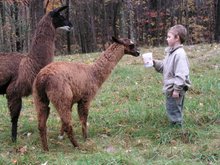
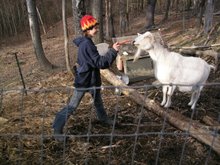

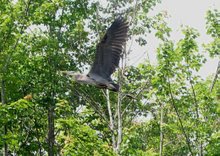

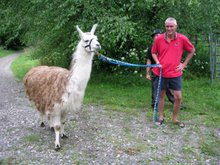
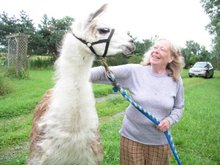
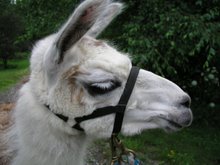








No comments:
Post a Comment